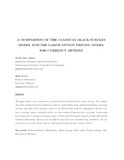| dc.contributor.author | Akinyi, Aduda Jane | |
| dc.contributor.author | Weke, PGO | |
| dc.date.accessioned | 2013-06-25T06:57:57Z | |
| dc.date.available | 2013-06-25T06:57:57Z | |
| dc.date.issued | 2008 | |
| dc.identifier.uri | http://hdl.handle.net/11295/39417 | |
| dc.description.abstract | This paper looks at the consequences of introducing heteroscedasticity in option pricing. The analysis
shows that introducing heteroscedasticity results in a better fitting of the empirical distribution of foreign
exchange rates than in the Brownian model. In the Black-Scholes world the assumption is that the variance
is constant, which is definitely not the case when looking at financial time series data. In this study
we therefore price a European call option under a Garch model Framework using the Locally Risk Neutral
Valuation Relationship. Option prices for different spot prices are calculated using simulations. We use
the non-linear in mean Garch model in analyzing the Kenyan foreign exchange market. | en |
| dc.language.iso | en | en |
| dc.subject | Heteroscedasticity | en |
| dc.subject | Black-Scholes | en |
| dc.subject | Option pricing | en |
| dc.subject | Garch model | en |
| dc.subject | Foreign exchange rates | en |
| dc.subject | Risk Neutral Valuation | en |
| dc.title | A COMPARISON OF THE CLASSICAL BLACK-SCHOLES MODEL AND THE GARCH OPTION PRICING MODEL FOR CURRENCY OPTIONS | en |
| dc.type | Working Paper | en |
| local.publisher | Department of Statistics and Actuarial Science; Jomo Kenyatta University of Agriculture & Technology | en |
| local.publisher | School of Mathematics, University of Nairobi | en |

